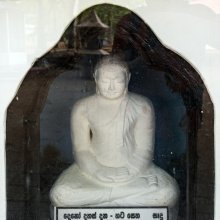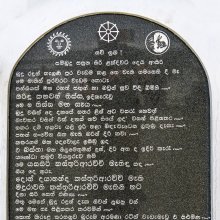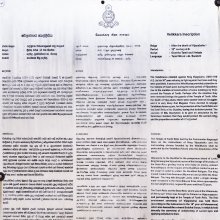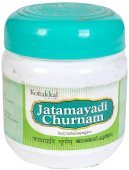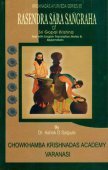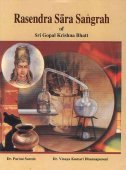Daha, Dāha: 32 definitions
Introduction:
Daha means something in Buddhism, Pali, Hinduism, Sanskrit, Jainism, Prakrit, Marathi, Hindi. If you want to know the exact meaning, history, etymology or English translation of this term then check out the descriptions on this page. Add your comment or reference to a book if you want to contribute to this summary article.
Alternative spellings of this word include Daah.
Images (photo gallery)
In Hinduism
Ayurveda (science of life)
Kalpa (Formulas, Drug prescriptions and other Medicinal preparations)
Source: Shodhganga: Edition translation and critical study of yogasarasamgrahaDāha (दाह) refers to “burning sensation” and is one of the various diseases mentioned in the 15th-century Yogasārasaṅgraha (Yogasara-saṅgraha) by Vāsudeva: an unpublished Keralite work representing an Ayurvedic compendium of medicinal recipes. The Yogasārasaṃgraha [mentioning dāha] deals with entire recipes in the route of administration, and thus deals with the knowledge of pharmacy (bhaiṣajya-kalpanā) which is a branch of pharmacology (dravyaguṇa).
Rasashastra (Alchemy and Herbo-Mineral preparations)
Source: Wisdom Library: Rasa-śāstraDāha (दाह) refers to “sensation of heat” according to the fifth volume of the Rasajalanidhi (chapter 19).
There are six kinds defined:
- Sensation of heat (daha) due to drinking of alcohol;
- Sensation of heat (daha) due to an abnormal excess of blood, all over the body;
- Sensation of heat (daha) due to suppression of thirst;
- Sensation of heat (daha) due to the stomach being filled up with blood caused by hemorrhage;
- Sensation of heat (daha) due to the loss of the dhatus (viz. chyle, blood, semen, flesh, hone, marrow, and fat);
- Sensation of heat (daha) due to the “marmas” or vital parts of the body (such as the head, heart, etc.);
Veterinary Medicine (The study and treatment of Animals)
Source: Asian Agri-History: Paśu Āyurvēda (Veterinary Medicine) in GaruḍapurāṇaDāha (दाह) refers to a “burning sensation”, according to Āyurveda sections in the Garuḍapurāṇa.—In Garuḍapurāṇa the vraṇa (ulcers/wounds) are classified broadly into two types based on the causative factors i.e.: (1) Āgantuja-vraṇa and (2) Doṣaja-vraṇa. They are sub classified based on the type of Doṣa, [e.g., Pittajavraṇa—The ulcers / wounds caused due to the derangement in pitta. The main characteristic feature is dāha (burning sensation)] [...].
Toxicology (Study and Treatment of poison)
Source: Shodhganga: Kasyapa Samhita—Text on Visha Chikitsa1) Dāha (दाह) refers to “thirst” or “burning sensation” and represents one of the ten symptoms of a snake-bite (daṃśaceṣṭita) that could be potentially fatal, as taught in the Ceṣṭita (“symptoms of snake-bites”) section of the Kāśyapa Saṃhitā: an ancient Sanskrit text from the Pāñcarātra tradition dealing with both Tantra and Viṣacikitsā—an important topic from Āyurveda which deals with the study of Toxicology (Agadatantra or Sarpavidyā).—The ten symptoms of a bite ordained by time/death that could be fatal mentioned by Kaśyapa are—horripilation, thirst/burning sensation (dāha), profuse sweat, phlegm, inflammation/irritation of all the organs of the body, debility/lack of control of all the organs, salivation, incoherent blabbering, lack of memory and finally death.
2) Daha (दह) or “cauterisation” refers to one of the eight sections of Cikitsā or “(medical) treatment (for poison)”, according to the Kāśyapa Saṃhitā.—In the penultimate Adhyāya of the Kāśyapasaṃhitā (XII. 63) the sage states that cikitsā or treatment for poison is eight-fold [viz., cauterisation (daha)]. Formulations prescribed by Kāśyapa are reckoned for their easy availability, sheer clarity and easy administration. Rather than the use of chemicals, acids, bromides etc. he has drawn from the vast storehouse of nature, more so the vegetable kingdom whose efficacy has been observed, tried and recommended from time to time.
Unclassified Ayurveda definitions
Source: Wisdom Library: Āyurveda and botanyDāha (दाह):—A Sanskrit technical term translating to a “burning sensation” color of the skin, and is used throughout Ayurvedic literature such as the Caraka-saṃhitā and the Suśruta-saṃhitā. Dāha is a symptom (rūpa) considered to be due to involvement of pitta-doṣa (aggravated pitta).
Source: archive.org: Vagbhata’s Ashtanga Hridaya Samhita (first 5 chapters)Dāha (दाह) refers to “heat”, as mentioned in verse 3.29 of the Aṣṭāṅgahṛdayasaṃhitā (Sūtrasthāna) by Vāgbhaṭa.—Accordingly, “[...] Alcohol (is) not to be drunk, or to be drunk (only) in small quantities or with much water; otherwise it causes cutaneous swellings, flaccidity, heat [viz., dāha], and stupor. [...]”.
Note: The copulative compound śopha-śaithilya-dāha-moha (“cutaneous swellings, flaccidity, heat, and stupor”) has been resolved into a series of predicatively used adjectives: kha bskams lhod thsa daṅ rmoṅs-pa (“dry in the mouth, flaccid, hot, and stuporous”). For śopha (“cutaneous swelling”) the translators read apparently śoṣa (“xerostomia”, given as a variant in the Kottayam edition); CD write kha skom instead of kha bskams, which would mean “thirsty in the mouth”.
Source: Research Gate: Internal applications of Vatsanabha (Aconitum ferox wall)Dāha (दाह) refers to “burning sensation”. Vatsanābha (Aconitum ferox), although categorized as sthāvara-viṣa (vegetable poisons), has been extensively used in ayurvedic pharmacopoeia.
Source: gurumukhi.ru: Ayurveda glossary of termsDāha (दाह):—[dāhaṃ] Burning sensation.

Āyurveda (आयुर्वेद, ayurveda) is a branch of Indian science dealing with medicine, herbalism, taxology, anatomy, surgery, alchemy and related topics. Traditional practice of Āyurveda in ancient India dates back to at least the first millenium BC. Literature is commonly written in Sanskrit using various poetic metres.
Natyashastra (theatrics and dramaturgy)
Source: Wisdom Library: Nāṭya-śāstraDāha (दाह, “burning sensation”) represents the third stage of the action of poison (viṣa) after drinking it, according to the Nāṭyaśāstra chapter 26. In a dramatic play, the representation of death from drinking poison is displayed by throwing out of hands and feet and other limbs. The power of the poison will lead to the quivering action of the different parts of the body.
Dāha according to the Nāṭyaśāstra: “burning sensation (dāha) should be represented by shaking of the entire body, feeling pain, scratching the different limbs and throwing out the hands and other limbs”.

Natyashastra (नाट्यशास्त्र, nāṭyaśāstra) refers to both the ancient Indian tradition (shastra) of performing arts, (natya—theatrics, drama, dance, music), as well as the name of a Sanskrit work dealing with these subjects. It also teaches the rules for composing Dramatic plays (nataka), construction and performance of Theater, and Poetic works (kavya).
Purana and Itihasa (epic history)
Source: archive.org: Puranic Encyclopedia1) Daha (दह).—One of the eleven Rudras. He was the grandson of Brahmā and the son of Sthāṇu. (Mahābhārata, Ādi Parva, Chapter 66, Stanza 3).
2) Daha (दह).—An attendant given to Subrahmaṇya by Aṃśa, a god. (Mahābhārata, Śalya Parva, Chapter 45, Stanza 34).
Source: archive.org: Shiva Purana - English TranslationDāha (दाह) refers to a “burning sensation”, according to the Śivapurāṇa 2.4.2 (“The birth of Śiva’s son”).—Accordingly, as Agni said to Śiva: “O lord of gods, I am a stupid and deluded servant of yours. Forgive me my fault. Please remove my burning sensation (dāha). O lord, you are the benefactor and sympathetic to the distressed”.

The Purana (पुराण, purāṇas) refers to Sanskrit literature preserving ancient India’s vast cultural history, including historical legends, religious ceremonies, various arts and sciences. The eighteen mahapuranas total over 400,000 shlokas (metrical couplets) and date to at least several centuries BCE.
Shaivism (Shaiva philosophy)
Source: SOAS University of London: Protective Rites in the Netra TantraDāha (दाह) refers to “burning (the thread)” (of the bonds), according to the Netratantroddyota commentary on the Netratantra of Kṣemarāja: a Śaiva text from the 9th century in which Śiva (Bhairava) teaches Pārvatī topics such as metaphysics, cosmology, and soteriology.—Accordingly, [verse 4.5cd-6, while describing the purification process of the initiand]—“[...] Once he has performed the saṃskāra [called] separation, whose nature is the absence of being the agent of experience, once all bhogas have been completed]. Then, as proclaimed by tradition, [he should] cut the bonds with the astramantra. [Then, after [he has] cut the binding ties with the astramantra, which is taught to follow immediately after this separation, with the same [mantra] he should] burn (dāha) [that thread by casting it into ritual fire”.

Shaiva (शैव, śaiva) or Shaivism (śaivism) represents a tradition of Hinduism worshiping Shiva as the supreme being. Closely related to Shaktism, Shaiva literature includes a range of scriptures, including Tantras, while the root of this tradition may be traced back to the ancient Vedas.
Yoga (school of philosophy)
Source: ORA: Amanaska (king of all yogas): A Critical Edition and Annotated Translation by Jason Birch1) Dāha (दाह) refers to “(suffering from) excessive heat”, according to the Yogayājñavalkya, an ancient Sanskrit text from the 8th century dealing with the eight components of Yoga in over 500 verses.—Accordingly, [while describing a practice of breathing]: “Having drawn the breath in through the tongue [whose edges are curled up to form a tube], the man who constantly drinks [the breath this way] does not [suffer from] fatigue or [excessive] heat (dāha) [in the body] and all [minor] diseases are cured. Having drawn in the breath at the junctures of the day or an hour before sunrise, he who drinks it [thus] for three months, good lady, [gains] eloquent speech and within six months of practice, he is freed from all serious diseases”.
2) Dāha (दाह) refers to the “burning” (of the digestive fire), according to the Dattātreyayogaśāstra 146-47 (Cf. Haṭhapradīpikā 3.79 and Śivasaṃhitā 3.36 and 5.7).—Accordingly, “The action called Viparīta [by which the body is inverted] destroys all diseases. For one who frequently practises it, their digestive fire increases. [That person] should certainly procure plenty of food, O Sāṅkṛti, [because] if little food [is eaten], the digestive fire burns up (dāha) [the body]”.

Yoga is originally considered a branch of Hindu philosophy (astika), but both ancient and modern Yoga combine the physical, mental and spiritual. Yoga teaches various physical techniques also known as āsanas (postures), used for various purposes (eg., meditation, contemplation, relaxation).
In Buddhism
Theravada (major branch of Buddhism)
Source: Dhamma Dana: Pali English GlossaryM (Pond).
Theravāda is a major branch of Buddhism having the the Pali canon (tipitaka) as their canonical literature, which includes the vinaya-pitaka (monastic rules), the sutta-pitaka (Buddhist sermons) and the abhidhamma-pitaka (philosophy and psychology).
In Jainism
General definition (in Jainism)
Source: The University of Sydney: A study of the Twelve Reflections1) Dāha (दाह) refers to the “burning (of the town)”, according to the Yogaśāstra vol. 2, p. 859, l. 5.—Accordingly, “Also Nami, knowing the difference between the self and wealth, said to Indra with regard to the burning of the town (pur-dāha), in the burning of the town of Mithilā nothing burns me”.
2) Dāha (दाह) refers to a “burning” (in the heart of men), according to the 11th century Jñānārṇava, a treatise on Jain Yoga in roughly 2200 Sanskrit verses composed by Śubhacandra.—Accordingly, “Those possessions which are pitiless, having imparted a great burning (unnata—dattvā dāham unnatam) in the heart of men, certainly will go away. How could they be for your pleasure?”.

Jainism is an Indian religion of Dharma whose doctrine revolves around harmlessness (ahimsa) towards every living being. The two major branches (Digambara and Svetambara) of Jainism stimulate self-control (or, shramana, ‘self-reliance’) and spiritual development through a path of peace for the soul to progess to the ultimate goal.
Languages of India and abroad
Pali-English dictionary
Source: BuddhaSasana: Concise Pali-English Dictionarydaha : (m.) like.
Source: Sutta: The Pali Text Society's Pali-English DictionaryDāha, see ḍāha. (Page 320)
— or —
Daha, (Sk. draha, through metathesis fr. hrada, hlād, see hilādate) a lake D.I, 45 (udaka°); J.I, 50; II, 104; V, 412; Miln.259; PvA.152; Dpvs.I, 44. (Page 317)
— or —
Ḍāha, (Sk. dāha, see ḍahati) burning, glow, heat D.I, 10 (disā° sky-glow=zodiacal light?); M.I, 244; PvA.62; Miln.325. Sometimes spelt dāha, e.g. A.I, 178 (aggi°); Sdhp.201 (id.);— dava° a jungle fire Vin.II, 138; J.I, 461. (Page 291)

Pali is the language of the Tipiṭaka, which is the sacred canon of Theravāda Buddhism and contains much of the Buddha’s speech. Closeley related to Sanskrit, both languages are used interchangeably between religions.
Marathi-English dictionary
Source: DDSA: The Molesworth Marathi and English Dictionaryḍaha (डह).—m The word sounded forth (esp. by child- ren of herdsmen in their play) by striking their fingers against their throat whilst bawling. v ghāla.
--- OR ---
ḍāha (डाह).—m (dāha S) The sensation of burning or internal heat.
--- OR ---
ḍāhā (डाहा).—&c. See under ḍāha.
--- OR ---
dahā (दहा).—a (daśa S) Ten.
--- OR ---
dahā (दहा).—m (Corruptly for dāha) Burning.
--- OR ---
dāha (दाह).—m (S) corruptly dāhā m Burning. 2 Burning, ardor, great heat (esp. morbid animal heat).
--- OR ---
dāhā (दाहा).—a (daśa S) Ten.
Source: DDSA: The Aryabhusan school dictionary, Marathi-Englishḍāha (डाह).—m The sensation of burning or internal heat.
--- OR ---
dahā (दहा).—a Ten. m Burning.
--- OR ---
dāha (दाह) [-hā, -हा].—m Burning. Great heat, ardour.
--- OR ---
dāhā (दाहा).—a Ten. dāhācā hāta m The hand of ten, i. e., of a number united. A phrase expressive of the power of confedera- tion or union. dāhācā hāta duśmānāvara paḍūṃ nayē Let not the hand of ten (let not an united body) fall even upon an enemy.
Marathi is an Indo-European language having over 70 million native speakers people in (predominantly) Maharashtra India. Marathi, like many other Indo-Aryan languages, evolved from early forms of Prakrit, which itself is a subset of Sanskrit, one of the most ancient languages of the world.
Sanskrit dictionary
Source: DDSA: The practical Sanskrit-English dictionaryDāha (दाह).—[dah-bhāve-ghañ]
1) Burning, conflagration; दाहशक्तिमिव कृष्णवर्त्मनि (dāhaśaktimiva kṛṣṇavartmani) R.11.42; छेदो दंशस्य दाहो वा (chedo daṃśasya dāho vā) M.4.4; Kirātārjunīya 5.14.
2) Glowing redness (as of the sky).
3) The sensation of burning, internal heat.
4) Feverish or morbid heat.
5) A place of cremation; Vās.19.26.
6) Cauterizing; M.4.4.
Derivable forms: dāhaḥ (दाहः).
--- OR ---
Dāha (दाह).—&c. See under दह् (dah).
See also (synonyms): dāhaka, dāhana, dāhya.
Source: Cologne Digital Sanskrit Dictionaries: Edgerton Buddhist Hybrid Sanskrit DictionaryḌaha (डह).—(-ḍaha) for Pali daha, Sanskrit hrada (Lex. draha), see s.v. Deva-ḍaha.
--- OR ---
Dāha (दाह).—(m.; in this sense seems unrecorded in Sanskrit, Pali, or Prakrit), fig. pain, sorrow: sarva-dāha-vināśanī Mahāvastu i.314.13 (verse), said of Buddha's voice.
Source: Cologne Digital Sanskrit Dictionaries: Shabda-Sagara Sanskrit-English DictionaryDāha (दाह).—m.
(-haḥ) 1. Burning, combustion. 2. Morbid heat. 3. Actual or potential cautery. E. dah to burn, ghañ aff.
Source: Cologne Digital Sanskrit Dictionaries: Benfey Sanskrit-English DictionaryDāha (दाह).—i. e. dah + a, m. 1. Burning, [Mānavadharmaśāstra] 4, 115. 2. Conflagration, [Rāmāyaṇa] 1, 3, 31. 3. Cauterising, [Suśruta] 1, 47, 8. 4. Feverish heat, [Suśruta] 1, 34, 16.
Source: Cologne Digital Sanskrit Dictionaries: Cappeller Sanskrit-English DictionaryDāha (दाह).—[masculine] burning (tr. & [intransitive]), combustion, burning-place; heat, glow, fire.
Source: Cologne Digital Sanskrit Dictionaries: Monier-Williams Sanskrit-English Dictionary1) Dāha (दाह):—m. ([from] √dah) burning, combustion, conflagration, heat, [Kātyāyana-śrauta-sūtra; Manu-smṛti; Yājñavalkya; Mahābhārata; Rāmāyaṇa] etc.
2) place of cremation, [Vasiṣṭha xix, 26]
3) glowing, redness (of the sky cf. dig-), [Manu-smṛti; Mahābhārata; Varāha-mihira’s Bṛhat-saṃhitā] etc.
4) cauterizing, cautery (of a wound), [Suśruta; Mālavikāgnimitra iv, 4]
5) internal heat, fever, [Suśruta]
6) [plural] Name of a people ([varia lectio] for vaideha), [Vāyu-purāṇa 1]
Source: Cologne Digital Sanskrit Dictionaries: Yates Sanskrit-English DictionaryDāha (दाह):—(haḥ) 1. m. Burning; heat.
Source: DDSA: Paia-sadda-mahannavo; a comprehensive Prakrit Hindi dictionary (S)Dāha (दाह) in the Sanskrit language is related to the Prakrit word: Dāha.
[Sanskrit to German]
Sanskrit, also spelled संस्कृतम् (saṃskṛtam), is an ancient language of India commonly seen as the grandmother of the Indo-European language family (even English!). Closely allied with Prakrit and Pali, Sanskrit is more exhaustive in both grammar and terms and has the most extensive collection of literature in the world, greatly surpassing its sister-languages Greek and Latin.
Hindi dictionary
Source: DDSA: A practical Hindi-English dictionary1) Ḍāha (डाह) [Also spelled dah]:—(nm) jealousy, envy, ~[hī] jealous, envious.
2) Daha (दह) [Also spelled dah]:—(nm) a deep pool; in a river the spot where the water is exceptionally deep.
3) Dāha (दाह) [Also spelled daah]:—(nm) burning, heat; inflammation; mental agony; cremation; scald; ~[karma/kriyā/saṃskāra] cremation.
...
Prakrit-English dictionary
Source: DDSA: Paia-sadda-mahannavo; a comprehensive Prakrit Hindi dictionary1) Daha (दह) in the Prakrit language is related to the Sanskrit word: Draha.
2) Dāha (दाह) also relates to the Sanskrit word: Dāha.
Prakrit is an ancient language closely associated with both Pali and Sanskrit. Jain literature is often composed in this language or sub-dialects, such as the Agamas and their commentaries which are written in Ardhamagadhi and Maharashtri Prakrit. The earliest extant texts can be dated to as early as the 4th century BCE although core portions might be older.
Kannada-English dictionary
Source: Alar: Kannada-English corpusḌāha (ಡಾಹ):—
1) [noun] the act or process of burning or reducing something to ashes by combustion.
2) [noun] heat a) the condition or quality of being hot; b) the sensation of warmth; hotness.
3) [noun] a sensation of dryness in the mouth and throat for want of water; thirst.
--- OR ---
Daha (ದಹ):—[adjective] = ದಸ [dasa]2.
--- OR ---
Daha (ದಹ):—[noun] = ದಸ [dasa]3.
--- OR ---
Daha (ದಹ):—[noun] an act or instance of cheating or being cheated.
--- OR ---
Dāha (ದಾಹ):—[adjective] amounting to ten.
--- OR ---
Dāha (ದಾಹ):—
1) [noun] the cardinal number ten; 10.
2) [noun] any value in the second place from right, in a multi-digit number.
--- OR ---
Dāha (ದಾಹ):—
1) [noun] that which burns; the condition of burning.
2) [noun] the condition of the mind characterised by uncomfortableness, anxiety, distress or other painful feelings.
3) [noun] the uncomfortable and burning sensation caused by the need for drinking water; thirst.
4) [noun] a strong desire.
5) [noun] ದಾಹ ಹತ್ತಿದವನಿಗೆ ಕುಡಿಯುವುದಕ್ಕೆ ಹತ್ತಿ ಕೊಡು [daha hattidavanige kudiyuvudakke hatti kodu] dāha hattidavanige kuḍiyuvudkfke hatti koḍu to offer, in sympathy, to a distressed person something that is useless; to offer a shoulder of mutton for a sick horse.
Kannada is a Dravidian language (as opposed to the Indo-European language family) mainly spoken in the southwestern region of India.
See also (Relevant definitions)
Starts with (+102): Daha-garnu, Daha-rakhnu, Dahaca Hata, Dahacikitsa, Dahada, Dahadaha, Dahadambara, Dahadana, Dahadhikara, Dahadhikartrikakarmanirnaya, Dahadikarmakartrinirnaya, Dahadikarmapaddhati, Dahadiva, Dahaga, Dahagollu, Dahaguru, Dahahara, Dahaharana, Dahai, Dahajala.
Ends with (+115): Adaha, Addaha, Agaradaha, Aggidaha, Agnidaha, Ajadaha, Amtrapradaha, Anabhidaha, Anatidaha, Angadaha, Angaradaha, Antardaha, Apradaha, Aravaladaha, Atadaha, Atidaha, Audaha, Avadaha, Ayodaha, Badaha.
Full-text (+225): Dahajvara, Antardaha, Digdaha, Dahasara, Agaradaha, Dahaharana, Atidaha, Dahavat, Dahaguru, Shavadaha, Daham, Tuladaham, Daho, Didhem, Dahasaras, Dahamaya, Gehadaha, Rugdaha, Padadaha, Vahnidahasamudbhava.
Relevant text
Search found 42 books and stories containing Daha, Dāha, Ḍāha, Dāhā, Dahā, Ḍāhā, Ḍaha; (plurals include: Dahas, Dāhas, Ḍāhas, Dāhās, Dahās, Ḍāhās, Ḍahas). You can also click to the full overview containing English textual excerpts. Below are direct links for the most relevant articles:
Sahitya-kaumudi by Baladeva Vidyabhushana (by Gaurapada Dāsa)
Text 10.130 < [Chapter 10 - Ornaments of Meaning]
Text 7.149 < [Chapter 7 - Literary Faults]
Text 10.222 < [Chapter 10 - Ornaments of Meaning]
Dhammapada (Illustrated) (by Ven. Weagoda Sarada Maha Thero)
Verse 31 - The Story of a Certain Monk < [Chapter 2 - Appamāda Vagga (Heedfulness)]
Verse 71 - The Story of Snake-Ghost < [Chapter 5 - Bāla Vagga (Fools)]
Brihad Bhagavatamrita (commentary) (by Śrī Śrīmad Bhaktivedānta Nārāyana Gosvāmī Mahārāja)
Verse 2.2.62 < [Chapter 2 - Jñāna (knowledge)]
Verse 1.1.4 < [Chapter 1 - Bhauma (the earthly plane)]
Rig Veda (translation and commentary) (by H. H. Wilson)
Trishashti Shalaka Purusha Caritra (by Helen M. Johnson)
Thirty-six weapons < [Notes]
A Manual of Khshnoom (by Phiroz Nasarvanji Tavaria)
Chapter VI < [Part I]
Related products
